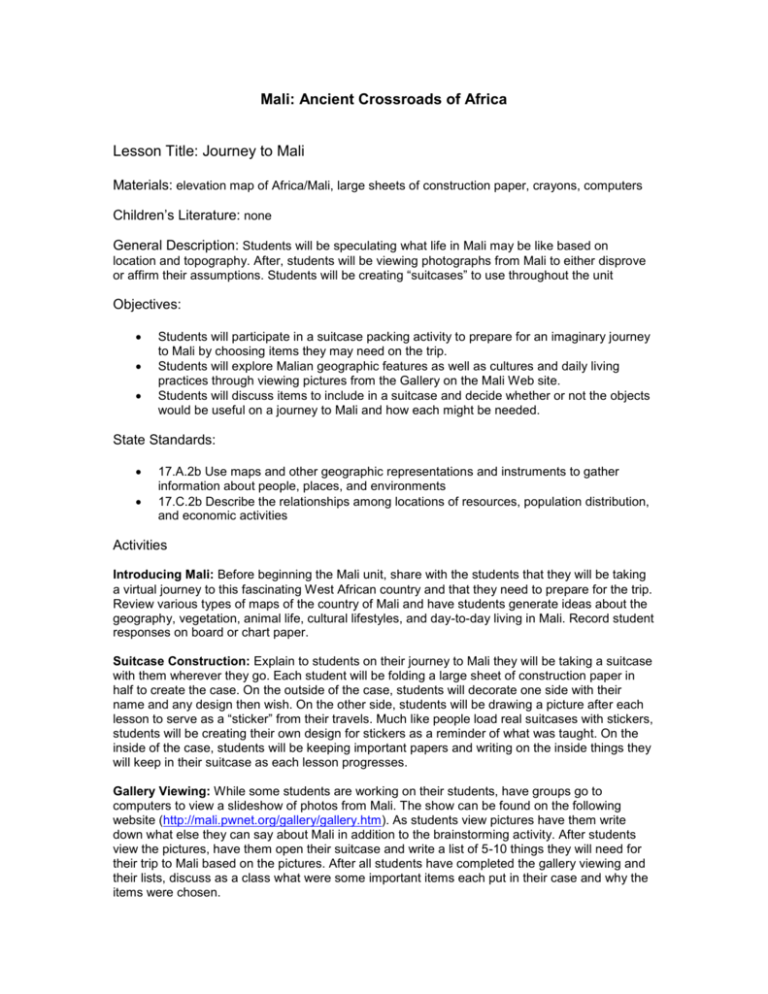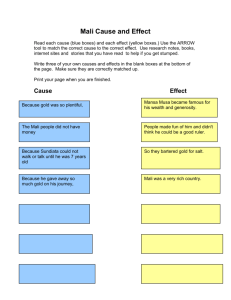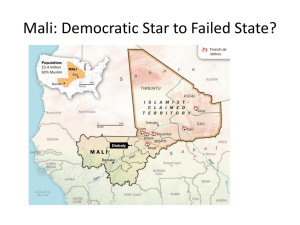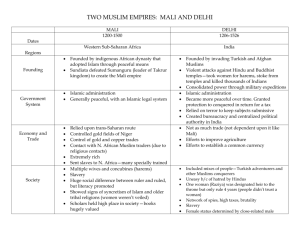Mali: Ancient Crossroads of Africa - Introducing an Educator
advertisement

Mali: Ancient Crossroads of Africa Lesson Title: Journey to Mali Materials: elevation map of Africa/Mali, large sheets of construction paper, crayons, computers Children’s Literature: none General Description: Students will be speculating what life in Mali may be like based on location and topography. After, students will be viewing photographs from Mali to either disprove or affirm their assumptions. Students will be creating “suitcases” to use throughout the unit Objectives: Students will participate in a suitcase packing activity to prepare for an imaginary journey to Mali by choosing items they may need on the trip. Students will explore Malian geographic features as well as cultures and daily living practices through viewing pictures from the Gallery on the Mali Web site. Students will discuss items to include in a suitcase and decide whether or not the objects would be useful on a journey to Mali and how each might be needed. State Standards: 17.A.2b Use maps and other geographic representations and instruments to gather information about people, places, and environments 17.C.2b Describe the relationships among locations of resources, population distribution, and economic activities Activities Introducing Mali: Before beginning the Mali unit, share with the students that they will be taking a virtual journey to this fascinating West African country and that they need to prepare for the trip. Review various types of maps of the country of Mali and have students generate ideas about the geography, vegetation, animal life, cultural lifestyles, and day-to-day living in Mali. Record student responses on board or chart paper. Suitcase Construction: Explain to students on their journey to Mali they will be taking a suitcase with them wherever they go. Each student will be folding a large sheet of construction paper in half to create the case. On the outside of the case, students will decorate one side with their name and any design then wish. On the other side, students will be drawing a picture after each lesson to serve as a “sticker” from their travels. Much like people load real suitcases with stickers, students will be creating their own design for stickers as a reminder of what was taught. On the inside of the case, students will be keeping important papers and writing on the inside things they will keep in their suitcase as each lesson progresses. Gallery Viewing: While some students are working on their students, have groups go to computers to view a slideshow of photos from Mali. The show can be found on the following website (http://mali.pwnet.org/gallery/gallery.htm). As students view pictures have them write down what else they can say about Mali in addition to the brainstorming activity. After students view the pictures, have them open their suitcase and write a list of 5-10 things they will need for their trip to Mali based on the pictures. After all students have completed the gallery viewing and their lists, discuss as a class what were some important items each put in their case and why the items were chosen. Assessment Packing List Explanation: Students will choose 3 items on their list of items to bring and write a short paragraph answering the following questions: What items are you choosing to bring? Why did you choose these items? How do you plan to use these items when you get to Mali? Student responses will be assessed on their use of photographs as support, the appropriateness of their choices and they grammatical writing skills. Lesson Title: A Day in the Life Materials: pictures from Mali photo gallery, teapot, bowls, birdseed, map of Sahara desert growth Children’s Literature: none General Description: Students will be participating in and discussing various activities intended to simulate what life is like for citizens of Mali. These activities range from retrieving water after walking and carrying things on their head to examining the main crop and diet staple of Mali. After students have these experiences they will be completing a brief writing assignment detailing a day in the life of a Mali resident and will add a sticker to their suitcase. Objectives: Students will explore everyday life in Mali. Students will learn how the people of Mali have adapted to their environment by participating in some of the daily routines practiced there. State Standards: 17.C.2b Describe the relationships among locations of resources, population distribution, and economic activities Activities: Water Resource Management: Fill a teapot or similar size container with water and have the students use various measuring devices to figure out the volume of water in the container. Next, tell the students that a typical Malian would only have that amount of water to use for bathing and washing each day. To help the students further understand the scarcity of water as a natural resource, have them walk, possible at recess, for five minutes with an empty bucket on their head and tell them that the distance from a water source in a typical Malian village is about this distance. Discuss the importance of water and how the environment in Mali plays a role in the availability of this precious resource. Scarcity of Wood: Show the students the Sahara desert on a the map of West Africa and talk to them about the concept of deforestation (clearing the land of trees) and how the depletion of the forests in Mali is causing the desert to grow. Discuss how the forests and trees are important as a natural resource. Next, have the students point out all of the various items in the classroom that are made of wood as well as objects they see at home and other places. Take away the students' chairs for five minutes and let them know that a typical Malian school does not have chairs or desks. Children who are lucky enough to be able to attend school either sit on the dirt floor of the classroom or carry a stool from home each day to school. Stools are small chunks of wood with four small legs and only wealthy families would have these. Wood is a scarce commodity in Mali and so children and adults as well squat by resting their elbows on their knees when they need to sit. Paper, pencils, and books are also in short supply in a typical Malian village so have the students try using charcoal on some recycled paper (like a cement bag) to get the full effect. Also, all lessons are copied directly from the chalkboard (students do not have textbooks) so have the students spend time day copying everything they do from the board. Steady Hands: In Mali, heavy items are typically carried on the top of a person's head as opposed to in one's arms. This is a cultural tradition of many of the ethnic groups in Mali who are nomadic and travel long distances on foot. When done correctly, it actually distributes the weight of the objects being carried evenly and is better on the back. Have the students try this out. Millet Mush: Explain to the students that the harsh climate of Mali as well as the lack of significant rainfall limits the types of food that can be grown. Show them the millet balls from the birdseed mixture and tell them that this is the primary crop grown for people. Assessment: A Day in the Life: After learning about some daily activities of young children in Mali, students will be writing a brief journal entry detailing what a day would be like if they were in Mali. Entries will be placed in suitcases and students will complete a sticker to match the day’s lesson. Paragraphs will be assessed on student integration of experiences during class, using photos and background knowledge for support, and finally for structure and grammar. Lesson Title: To Market, To Market Materials: maps of West Africa, recycled materials, salt, gold wrapping paper, glue, scissors Children’s Literature: none Objectives: Students will identify early Mali as a wealthy trading empire. Students will participate in a bartering activity to appreciate the early trading practices of Mali. Students will record experiences through a creative writing activity. State Standards: 15.D.2a Explain people and countries voluntarily exchange goods and services 17.C.2b Describe relationships among location of resources, population distribution, and economic activities Activities: Resources of Ancient Africa: Using a large map of Africa, locate the approximate early empire of Mali. Point out to students this empire thrived on trading salt from the Sahara Desert and gold mines from West Africa. Ask students the following guiding questions: We know gold costs a lot of money, but why would salt bring in so much money? For the people of the desert, salt was a natural resource. People used salt for their health and for preserving foods. Miners found gold in Western Africa. Therefore, salt was traded for gold. Based on our experience in the coalmines, what do you think life would be like for those mining gold? What do you know about natural resources and their longevity? After students discuss the questions, have them work in small groups to create maps of this ancient trading route using maps, glue, salt, and gold wrapping paper. Have students discuss why each item is valuable and how much salt should be traded for gold to make a fair deal. Mali’s Markets Today: After students have discussed what Mali traded years ago, they will fast forward to the present and examine Mali’s markets. Students will be looking at photos of Mali’s markets while the teacher explains how people sell goods they have made from recycled materials. Mali is a very poor country and people must be resourceful to make money for food, shelter, and clothing. To demonstrate their ability to resourceful, students will be created items to sell at the market using recycled materials. Students will be using paper products (i.e. paper towel holders, toilet paper holders, etc.), fabric scrapes, seashells, and other products to create items to sell in the market. Students will be selling these items in a simulated market. To make the experience authentic, ask students to bring in towels to sit on and use the currency of Mali to barter. Assessment Africa Maps & Market Participation: Students will be assessed on the resource maps they created as well as their participation in the market. Maps will be judged on accuracy and class participation during the activity. Market participation will be assessed on student involvement and commitment to the simulation. Lesson Title: The Village Voice Materials: suitcases, Sundiata handout Children’s Literature: Wisniewski, David. Sunidata: Lion King of Mali. Clarion Books. (New York, NY: 1992). Objectives: Students will identify the important role of Griots as storytellers in Mali and their responsibility to pass on traditions from one generation to the next. Students will recognize that most of what we know about Mali's history comes from oral accounts that were handed down from generation to generation. Students will practice being Griots by retelling a well-known Mali folktale to each other and their families. State Standards 1.C.2d Summarize and make generalizations from content and relate to purpose of material 26.B.2b Demonstrate action, characters, narrative skills, collaboration, environments, simple staging, and sequence of events and situations in solo and ensemble dramas 18.A.2 Explains ways in which language, stories, folktales, music, media, and artistic creations serve as expressions of culture Activities: Introducing Griots: Ask the students if they have any family traditions centered around a special event. Have the students record a family tradition in their travel journals. Talk about these personal traditions as well as the various holidays we celebrate in the United States and their historical significance. Explain that, in Mali, historical events and special occasions are honored as well. The role of the Griots, or storytellers, in Mali is to preserve the history of this country by passing on its traditions with oral accounts. These accounts can be in the form of a song, a poem, or a riddle. The responsibility of the Griot to collect, record, and share information with his fellow villagers was important to the early empire of Mali and is still valued today as a means to preserve the history and customs of this country. Griots not only share oral accounts of historical events, but they initiate the celebration of yearly activities such as the planting and harvesting seasons as well. They will sometimes present their stories in the form of a theatrical drama and have the villagers dress up to represent certain characters. The villagers wearing the masks will not have any speaking parts; they will merely act out the motions and emotions of the story. The Griot always narrates these productions and is the only one allowed to speak. The job of the Griot is well respected and is passed down each generation from the Griot to his oldest son. Read Aloud, Sundiata the Lion King of Mali: Explain to students this story has been around for centuries in Mali. Through the oral tradition of sharing stories it has made its way to the 21 st century into this book. This famous tale is about the Lion King of Mali, a former and wellrespected real king of the country. While students are listening to the book, they will be taken notes about the plot events on their handouts because they will be retelling the story as a part of the assessment. After the book is read aloud, discuss the plot with the students so all have a chance to review the content. Have students brainstorm some important details that should be included in the retelling. Write these ideas on the board or on chart paper. Assessment: Suitcase Sticker: Based on students’ experiences today they will add another sticker to the front of their suitcase to represent their learning. Becoming a Griot: Students will use their notes on the story to create their own version to share with their family and classmates. Students will be assessed on their accuracy in the retelling, their speaking abilities, and their use of some dramatic movements of Griots described to students during the lesson. Lesson Title: Sharing the Mali Experience Materials: Why Hippos Live in the Water scripts Children’s Literature: none Objectives: Students will work in groups to share their knowledge about Griots and the importance of Mali folktales to other students in the school. Students will participate in a live group retelling of a West African folktale. State Standards: 26.B.2b Demonstrate action, characters, narrative skills, collaboration, environments, simple staging, and sequence of events and situations in solo and ensemble dramas Activities: Introducing the Story: Explain to students as a culminating activity for our study of Mali, they will be performing a short play based on a West African folktale. Many times a folktale explains why something is the way it is in nature. The tale the students will be performing explains why hippos live in water. Students will be split into two groups and will take turns performing the tale for the students that come to the classroom to watch. Read Aloud, Why Hippos Live in the Water: Assign roles to select students to complete a brief read aloud of the story before splitting them into groups. After completing the reading, explain to students each of them will receive a role. Each role is important and each student needs to work hard to make the play a success. Play Practice: Split class into two groups and then assign roles accordingly. After each student has received their role have them take time to read through their part before practicing with the whole group. Work with each cast separately and emphasis the importance of students acting out the play rather than just reading the lines. This portion of the activity will take a few days and students should practice in consecutive days to keep the play fresh in their minds. Assessment: Mali Folktale Performance: Students will be assessed on their participation in the play. Their speaking, acting, and listening skills will be judged during the play. For students to receive full credit it is imperative they not only know their lines, but respect others while he/she is reading.







